15 Incredible Iceland Waterfalls And Where To Find Them
If you love waterfalls anywhere near as much as we do, then Iceland is the place for you. The Iceland waterfalls are amongst the most spectacular in the world and visiting a waterfall in Iceland should be top of your must see things to do in Iceland.
There are around 10,000 waterfalls in Iceland and each one is unique. We managed to visit a lot of the waterfalls during our 6 days in Iceland but there are still so many that we would like to visit.
We will definitely return to Iceland so we thought that we would ask some fellow travel bloggers (and waterfall enthusiasts) for their views on the best waterfalls in Iceland.
Many of these Icelandic waterfalls are located along the famous Ring Road (Route 1) that circumnavigates the whole country.
Or along the Golden Circle and are easily accessed all year round (even on a day trip from Reykjavik), but others are a little more hidden.
This post details where to find the best waterfalls in Iceland and when to visit them.
This post contains affiliate links. Should you buy something from one of them, we may earn a small commission but this is at no extra cost to you.
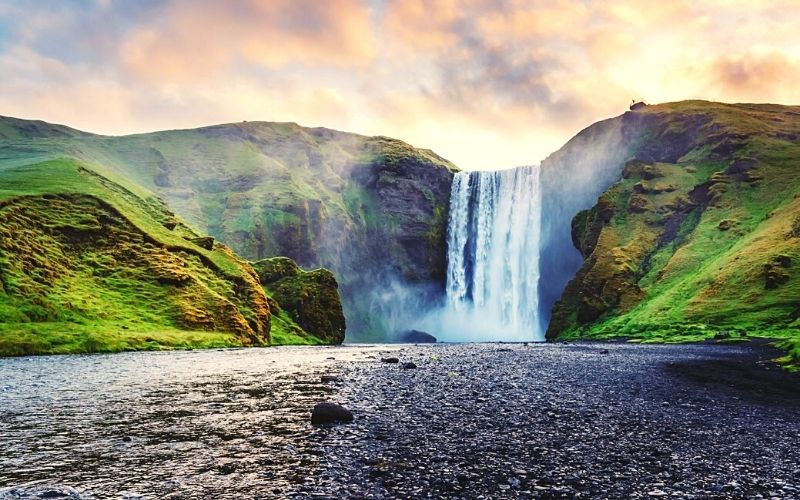
Before you read about the best Iceland waterfalls, here are a few things we learned about visiting Iceland (and visiting the waterfalls) that you may find helpful in planning your trip.
Tips for visiting the Iceland waterfalls
- Iceland can be expensive BUT it doesn’t have to be. Almost all of the natural beauty of Iceland can be explored for free. We recommend hiring a car in Iceland and doing a self-guided tour of the waterfalls. See more tips on how to do Iceland on a budget.
- Most of these waterfalls are easy to access being located just off the Ring Road, the Golden Circle or the Diamond Circle and only a short walk from the car park. Others require a bit more effort. Read these mini guides to help you understand which ones are more suitable for you.
- You can get very close to some of the waterfalls like Seljalandsfoss and Skogafoss. If you get close, you will be covered in spray so consider whether you want to wear waterproof clothing. If you are on a day out, particularly in winter, there is nothing more unpleasant than being in wet clothes when the temperatures are well below freezing!
- If you are wanting to take stunning shots of the waterfalls, plan your route carefully. Daylight hours vary greatly from summer to winter and during the winter months, you may find that the waterfall you are visiting is obscured by shadows.
- These are some of the most well-known waterfalls in Iceland but with over 10,000 waterfalls in Iceland, why not try spotting one of your own off the beaten track? See our bonus waterfall at the end of the post to find out what we mean.
- If you prefer not to hire a car, there are many tours you can do that will take you to some of the most popular waterfalls. Here are some examples.
Seljalandsfoss
Seljalandsfoss is one of the most famous waterfalls in Iceland, if not the most famous. If you want to know which waterfall can you walk behind in Iceland – it’s Seljalandsfoss! (although see below for the lesser know Kvernufoss).
The waterfall is 65 metres high but quite narrow. It is part of the Seljalandsá river that originates under the glacier volcano Eyjafjallajökull (famous for the 2010 eruption that caused air traffic chaos).
It’s located about 120km from Reykjavik right on the Ring Road in the south of Iceland and is visible from the road. There is a large gravel car park just off the road (where you’ll also find a gift shop and a small café) and then a short walk to the waterfall. Because of its close proximity to the Ring Road, it is easily accessible all year round.
Note though, that if you want to walk behind the waterfall for that iconic shot, you will need to visit in the warmer months. The best time to visit Seljalandsfoss waterfall is between the end of May and the beginning of July and between 8 pm and 11 pm. This is when you will have the best chance of catching the incredible sunset shot.
If you are visiting Iceland in the winter, the path will most likely be closed off because it is too slippery and dangerous. We visited Iceland in October and it was closed due to ice. You will still get stunning views of the waterfall though.
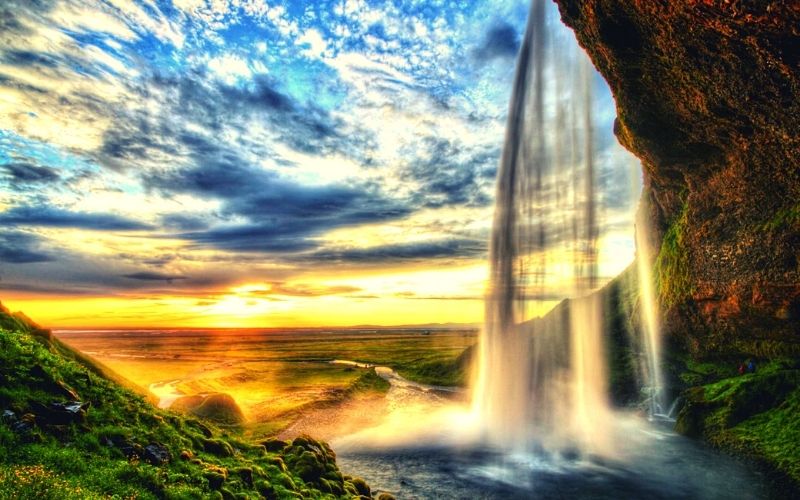
Seljalandsfoss
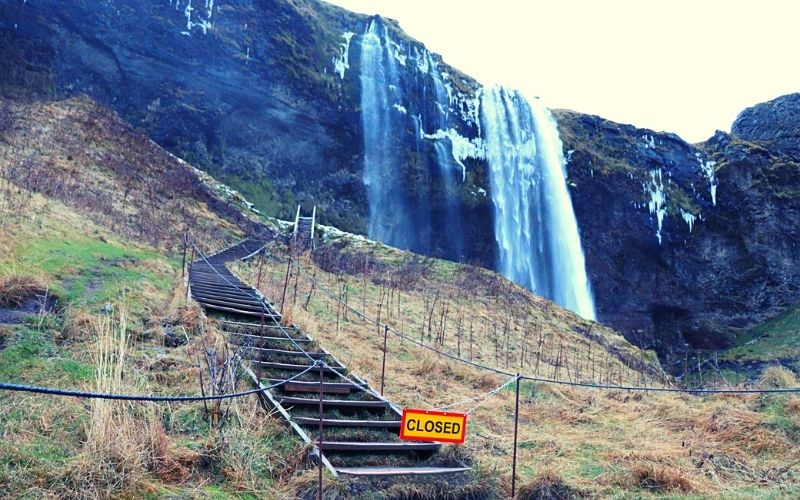
Seljalandsfoss in winter
Gljufrabui Waterfall
Submitted by Hannah from That Adventurer
Just a couple of minute’s walk away from Seljalandsfoss is another waterfall that far fewer people visit: Gljúfrabúi. Gljufrabui (also known as Gljúfrafoss) is tucked away through a narrow gorge and you’ll likely get your feet wet on the way to view the waterfall, but it’s a must-see during a weekend in Iceland! Remember to take waterproof jackets and boots as you’ll get wet viewing it too.
Gljúfrabúi waterfall is 40m high and is fed by the Gljúfurá River. The waterfall gets its name from the way it’s formed with “Gljufur: meaning gorge or canyon and “-bui” meaning inhabitant. Putting that together gives you inhabitant of the gorge.
The easiest way to get to this waterfall is to park in the parking lot for Seljalandsfoss. From here, walk towards Seljalandsfoss and then follow the path to your right that goes alongside the canyon wall. Keep walking until you get to a larger stream coming out of the canyon walls and, if you peer inside, you should be able to see and hear Gljufrabui plummeting down. The walk is on flat terrain and only takes a couple of minutes but it can be super slippery in winter.
This waterfall is easy to visit all year round since it’s part of the popular Golden Circle route. Winter is very, very cold so just make sure you’ve got plenty of layers!
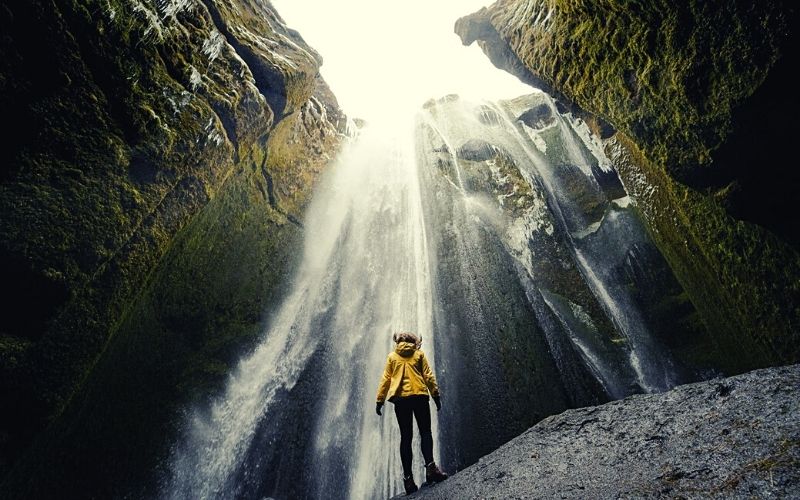
Gljúfrabúi waterfall in Iceland
Skogafoss
Skogafoss is located just off the Ring Road in the south of Iceland about 150 km east of Reykjavik. Due to it’s location on the popular Golden Circle route, it is one of the busiest waterfalls in Iceland so we would recommend getting here as early as you can.
Skógafoss waterfall is on the Skógá River and is one of the largest waterfalls in Iceland. It is 60 metres high and 25 metres wide and incredibly powerful. Just be warned that the spray fro the waterfall extends quite a way, so if you are thinking of getting up close and personal with it, you might want to consider taking waterproof clothing, particularly during the winter months.
You can walk to the waters’ edge at the bottom of the waterfall which is easily done during the summer months but during the winter, it is incredibly icy. You can also take the steep steps up to the top for great views of the surrounding landscape.
There is a large gravel car park with a tourist gift shop and a small café. You should also pop into the nearby Skogar Museum before or after visiting the falls. You’ll find interesting artifacts and historic buildings (including the iconic turf houses) and learn about Icelandic history.
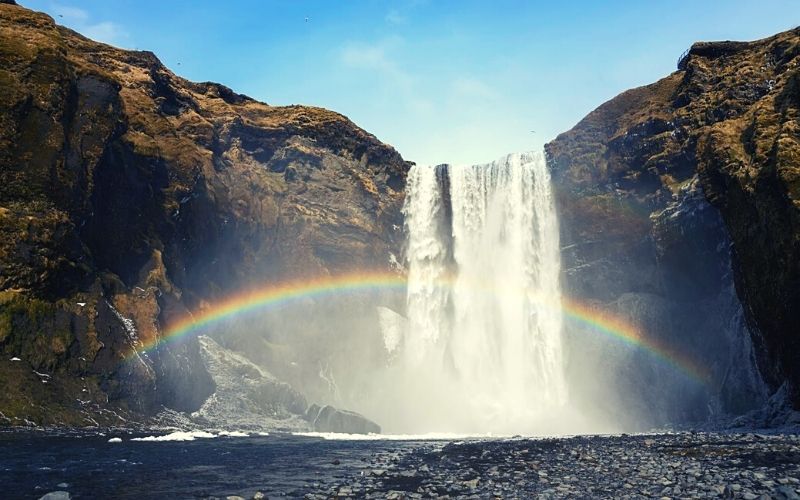
Skogafoss
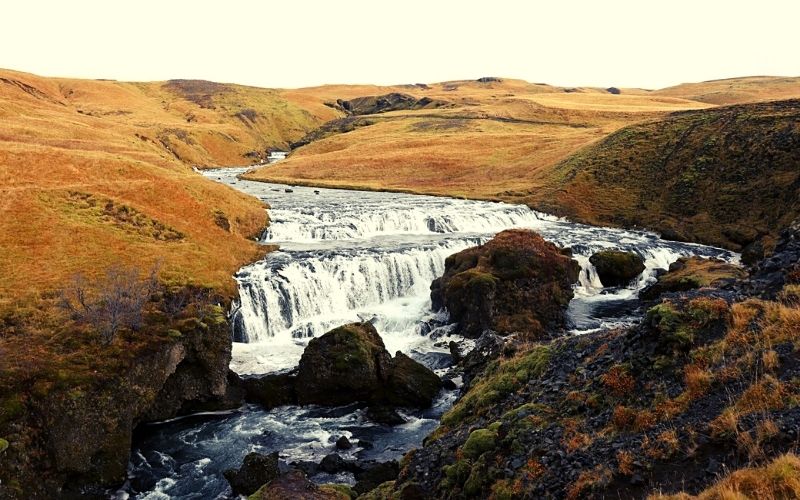
View at the top of Skogafoss
Kvernufoss
Kvernufoss waterfall is located just next door to Skogafoss (about 2 km) but it is often overlooked because it requires a bit more effort to get to it. It’s a 30 metre high waterfall and is half hidden in a gorge, making is a real hidden gem.
Park at the Skógar museum and follow the path to the waterfall which is about 600 metres away. In the summer months it is a really pleasant and peaceful walk without the crowds that you will encounter at Seljalandsfoss or Skógafoss. During the winter, the walk is much more of a challenge.
Just like Seljalandsfoss, you can walk behind Kvernufoss but it is slippery, even during the summer months. You will really need to have suitable footwear and we wouldn’t advise to take small children. It is also not advisable to walk behind the waterfall in the winter months as it is treacherous.
The best time of day to visit is midday to avoid as much of the shadow cast by the sides of the gorge as possible.
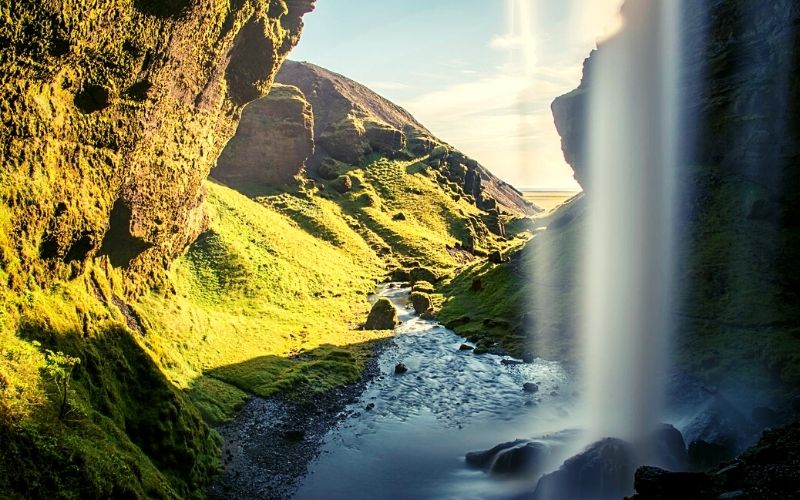
Kvernufoss
Kirkjufellsfoss
Kirkjufellsfoss waterfall is located next to the distinctly shaped Kirkjufell mountain in the north of the Snaefellsness Peninsula in north western Iceland. It’s about 183km (110 miles) north of Reykjavik and can be reached on a day trip but we would recommend taking a bit more time to explore the natural beauty of the peninsula.
Kirkjufellsfoss translates as Church Mountain Falls and is a short but nonetheless impressive waterfall. In winter the waterfall ices up and gives the impression of candle wax dripping over the edge. Despite it being quite small, it is one of the most visited of the Iceland waterfalls thanks to its location next to Kirkjufell.
There’s a small car park on the side of the road and it’s a short 5-minute walk to the top of the falls. To get the best view of the falls (in our opinion), head along the trail and over the bridge at the top of the waterfall to the other side. Here you will be able to look back over the waterfall with Kirkjufell in the background.
The best time to visit Kirkjufellsfoss in the summer is either at sunrise or sunset. During the winter months, try to avoid visiting after midday otherwise the falls will be in the shadow.
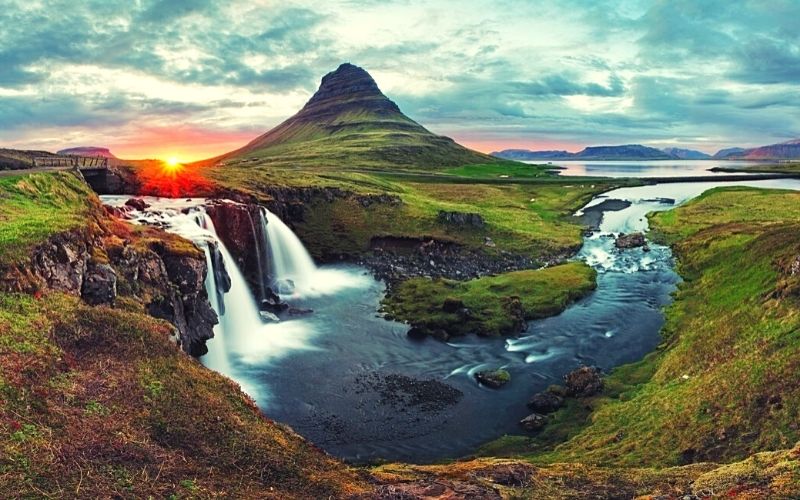
Kirkjufellsfoss

Kirkjufellsfoss in winter
Gullfoss
Translates at ‘Golden Falls’ Iceland. It is enormous and surprisingly outdoes Niagara Falls in terms of power. They will soon be harnessing this power to provide electricity to the south of Iceland. Gullfoss and the surrounding area were made a nature reserve in 1979.
There’s an enormous car park which gets quite full with lots of coaches. It’s a realatively short walk to the falls along a well constructed path to the first viewpoint and then a slightly further walk will take you along the top of the falls to the second viewpoint.
Gullfoss is easily visited all year round, although we noticed that a path down to the lower level for a closer look of the falls was closed in winter.
There’s a large café and a gift shop and toilets.
Don’t miss visiting Geysir which is just a short 10-minute drive. Gullfoss is also not far from the Secret Lagoon which, although not so secret these days, is a much better option than the highly touristy Blue Lagoon.
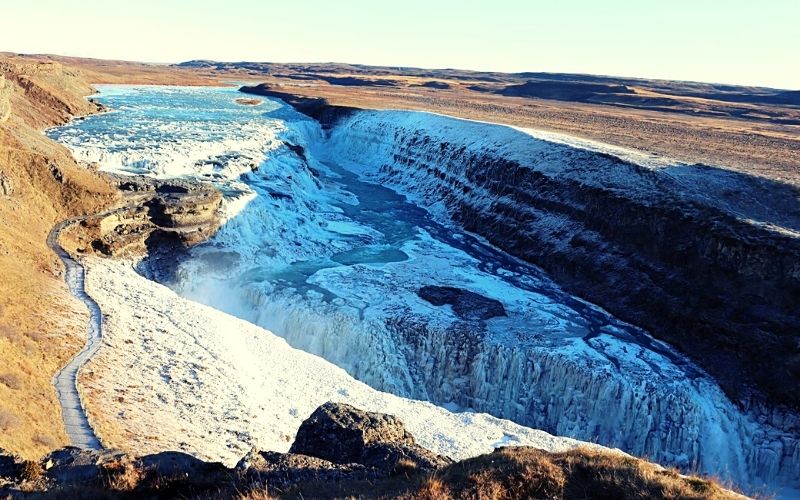
Gullfoss in winter
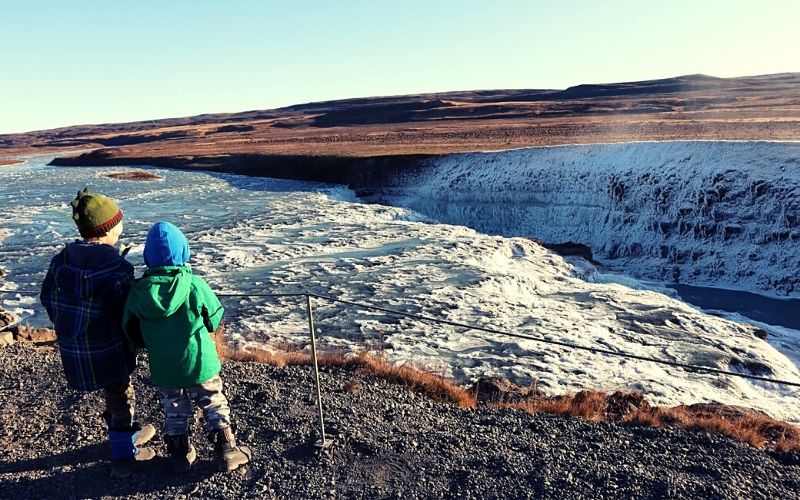
Path to the second viewpoint at Gullfoss
Godafoss
Submitted by Suzanne from Meandering Wild
Goðafoss is situated along the Diamond Circle sightseeing route and is about 53 kilometres from the northern city of Akureyri and 50 kilometres west of Húsavík. Coming from either direction you will see the signs for the waterfall from the Ring Road.
As you arrive at the waterfall parking area you will be able to see the mist rising from the falls and it is just a short walk along well-made paths to the main viewing point of the waterfall. There is a selection of viewing points on both sides of the river and a bridge downstream allows you to cross away from the road bridge.
The waterfall name means “Waterfall of the God’s” and it was named after the religious icons thrown into the falls around AD1000 when Iceland was converted to Christianity.
The falls are a small horseshoe with a drop of just 12 metres as the river Skjálfandafljót flows from Vatnajökull glacier to the sea. They are perfect year-round but especially beautiful in the winter months when the surrounding area is frozen and the northern lights can be seen above the falls.
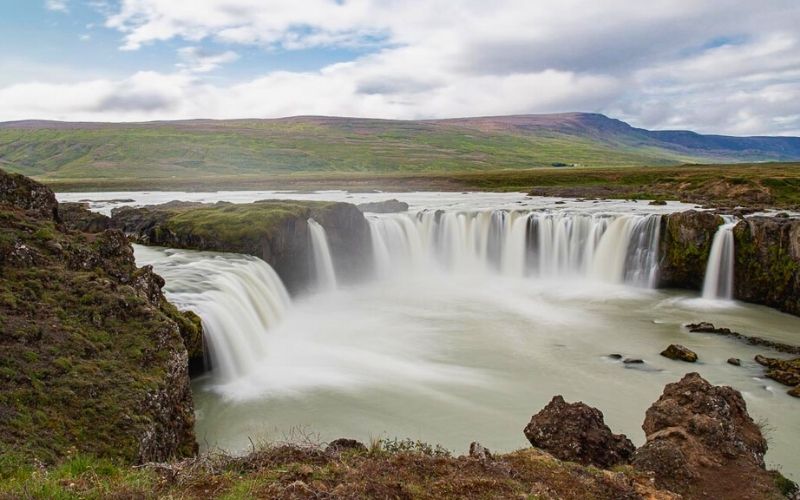
Godafoss Waterfall
Svartifoss
Svartifoss waterfall (which translates as black waterfall) is possibly the most visually incredible waterfalls in Iceland as it flows over black hexagonal basalt columns before dropping 20 metres to the pool below.
These black hexagonal columns are a unique natural phenomenon in Iceland. Other examples of these columns can be seen in Black Sand Beach (Reynisfara) and the Gerduberg Cliffs in the Snaefellsness Peninsula.
The waterfall is located in the Vatnajökull National Park in the south of Iceland. It is about 320 km east of Reykjavik and although you can do it in a day trip, it would be far better to stay in either Vik or Hof.
You can park at the visitor centre at Skaftafell and from there it is around a 1.5 – 2 kilometre hike to the waterfall with a slight upward incline.
The best time to visit Svartifoss is during the summer months because the hike would not be so easy during winter in Iceland. If you are there at sunset, you might just catch the sun sliding down behind the waterfall, giving a stunning photo opportunity.
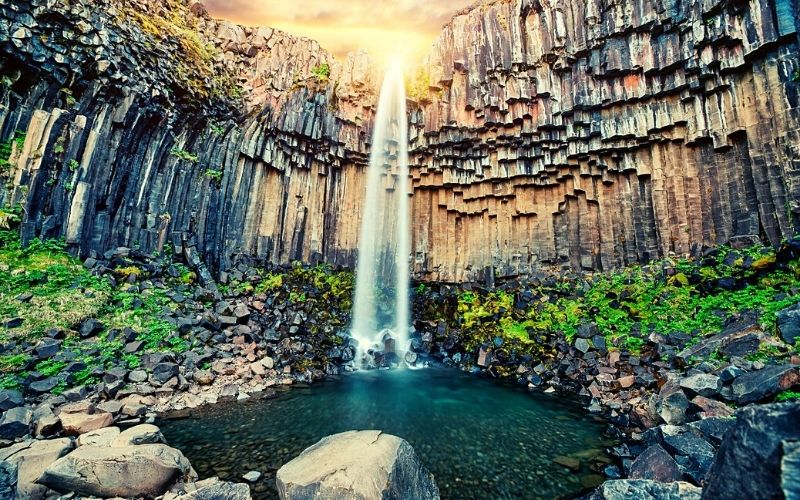
Svartifoss at sunset
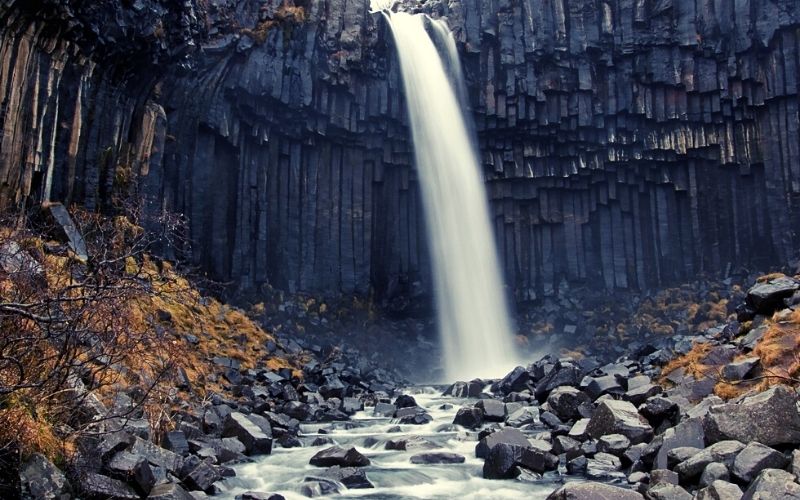
Black hexagonal columns at Svartifoss
Haifoss
Submitted by Rachel and Clark from Seeking Our Someday
Háifoss is one of the most striking waterfalls in Iceland. Falling 122m (400ft) to the valley floor below, Haifoss is the fourth highest waterfall on the island. The slightly smaller waterfall, Granni which is located next to Haifoss, gives way to breathtaking views.
The main viewpoint for Haifoss is from the top of the canyon and for more adventurous visitors, it is possible to hike down to the valley floor. There is a car park near the top of the falls, however, the final 8km (5 miles) of dirt road is only suggested for high ground clearance all-wheel drive vehicles. Smaller vehicles can park along the road and visitors can walk the remaining distance to the falls.
It is not recommended to visit Haifoss in the winter as snow makes it difficult to reach the falls from the main road. Learn more about visiting Haifoss as part of a 10 Day Itinerary around Iceland’s Ring Road.
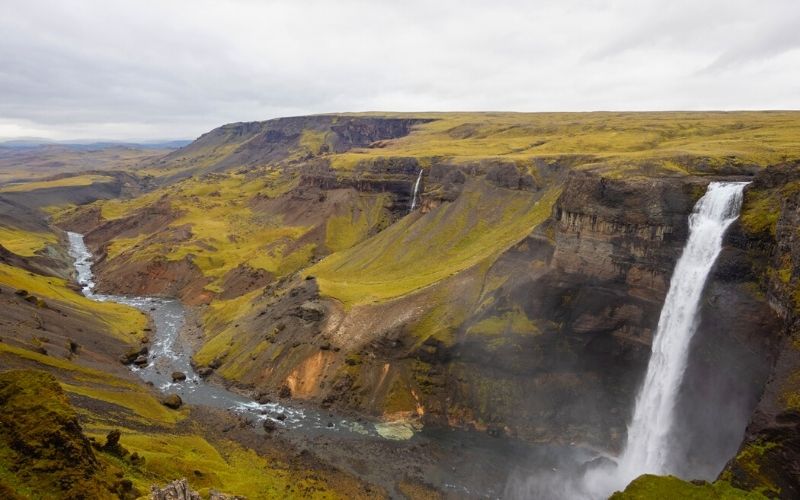
Haifoss Waterfall
Bruarfoss
Submitted by Nick & Val from Wandering Wheatleys
Most of the spectacular waterfalls in Iceland are right off the road so you can park and walk to them with minimal effort. While it’s wonderful to have such easily accessible attractions, it also means that you have to contend with big tour groups.
So if you’re looking for something a bit more off-the-beaten-path, you’ll definitely want to check out Bruarfoss Waterfall. Not only is it an adventure to get to, but we would argue that it’s one of the top highlights of Southern Iceland!
There is a parking lot for Bruarfoss Waterfall right off the highway but you’ll have to walk 2.2 miles from there to the falls. The path is flat but can get muddy and definitely gets a bit confusing. There are hand-painted signs along the way to guide you to the right place. The trail meanders through private property so please be respectful and pick up any trash along the way.
But you’ll know that the long walk was worth the effort once you reach the small wooden bridge that crosses the river. It’s a perfect vantage point to admire the bright turquoise water flowing over the black rocks to create a striking contrast of colors. It’s arguably the most beautiful waterfall in Iceland and you’re very likely to have it all to yourself!
You can enjoy the view of the falls from the bridge, or take the small dirt path on the left down to the base of the falls.

Bruarfoss
Barnafoss
Submitted by Kenny from KNYCX Journeying
Barnafoss (which translates as waterfall of the children) is a series of waterfalls on the river Hvítá located about 100 kilometers to the east of Reykjavik and close to the highlands of Iceland. While it is not the most spectacular waterfall in terms of its height and water volume, it is very different to the other Iceland waterfalls.
Here, the turquoise glacial waters from Hraunfossar (another waterfall just a short stroll away) gently cascade through the Hallmundarhraun lava field forming hundreds of small streams before entering the river Hvítá below.
Many waterfalls in Iceland are associated with Icelandic folklore and Barnafoss is no exception. Legend has it, two little boys who were left home alone when their parents went to church, decided to follow their parents. They mysteriously drowned when they crossed a stone bridge at Barnafoss and fell into the water. After this event their mother put a spell on the bridge: Whoever crosses the bridge will also be drowned. The bridge was later destroyed by an earthquake.
Barnafoss waterfall is easily accessible all year round.
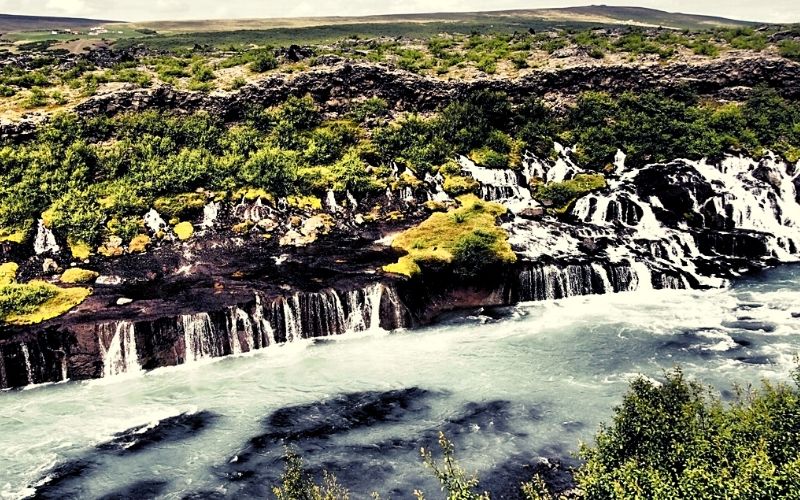
Barnafoss
Dynjandi Waterfall
Submitted by Greta from Greta’s Travels
If you’re looking for the most beautiful waterfalls in Iceland, then Dynjandi Falls has to feature on your list. Dynjandi is located in the Westfjords in the very north west of Iceland and one of the least travelled parts of the country.
Dynjandi Falls is actually composed of seven waterfalls, with a total height of 100 metres. Dynjandi is the name of the biggest waterfall, which starts at the top of the fjords and flows towards the coast forming a further six smaller waterfalls.
Entrance to Dynjandi is free and it’s very easy to reach. There is a big parking area just below the base of the waterfalls. You can walk up all the way to the base of Dynjandi along a well marked trail, with viewing platforms over the smaller waterfalls. The trail can get slippery because of the spray from the waterfalls, but it’s well marked and easy to walk along.
Dynjandi hasn’t hit the main tourist radar yet. Not many travellers make it to the Westfjords, which means you can admire the waterfalls and nature away from the crowds that you will see at the Golden Circle waterfalls.
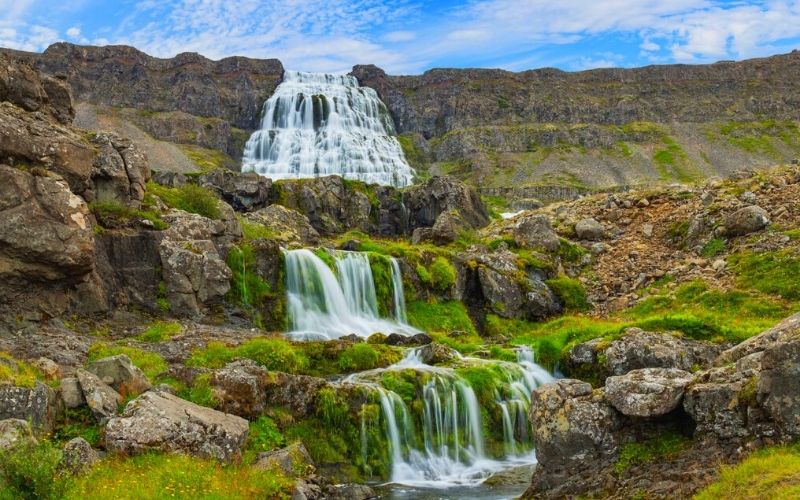
Dynjandi Waterfall
Glymur Waterfall
When visiting Iceland, most people drive around the Ring Road or the Golden Circle where there are plenty of waterfalls to see right by the side of the road but if you feel like a challenge, Glymur is the one for you.
Glymur is located just over an hours’ drive north west of Reykjavik. You can reach Glymur by taking a detour off the Ring Road just before the Hvalfjörður tunnel and drive along Road 47 following the coast east for about 40 km. At the end of the fjord, turn right and continue about 3 km until you reach the (free) car park. Note that there are no toilets here.
It is a very scenic (although significantly longer) alternative to taking the tunnel if you are heading on north to the Snaefellsness Peninsula or around the Ring Road but it is worth it to visit this stunning waterfall.
Glymur is the second highest waterfall in Iceland at a huge 198 metres and is only accessible by hiking to it. The hike can be challenging in parts as you have to cross rivers and walk along steep, rocky cliffs (not great for small kids). The views along the way are incredibly scenic though with paths lined with beautiful purple lupines.
The best time to visit Glymur is during the winter months. It is definitely not advisable to visit during the winter months.
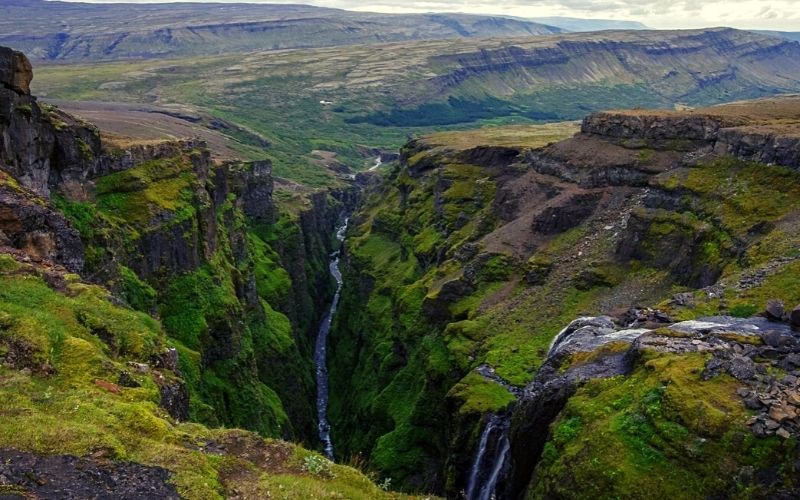
Glymur waterfall
Dettifoss
Submitted by Catherine from We Go With Kids
Most travelers to Iceland focus on the South side of the island, but if you venture north, you will experience some amazing sights in North Iceland. Dettifoss is located in North Iceland’s Diamond Circle.
Dettifoss waterfall is not visible from the Ring Road. And while many of the other Iceland waterfalls are visible from their parking lot, you need to hike on a steep gravel path for about 10 minutes to get to these falls.
The walk is easily doable for kids and worth it once you reach the viewpoint. Dettifoss, which is considered the most powerful waterfall in Europe, is absolutely stunning. The view from the top of the falls, and the intensity of the waterfall was amazing.
Even if you happen to visit on on a nice day, make sure to bring rain gear because there was quite a bit of mist. And, keep an eye out for rainbows. Visiting Dettifoss was one of our favorite things to in North Iceland.
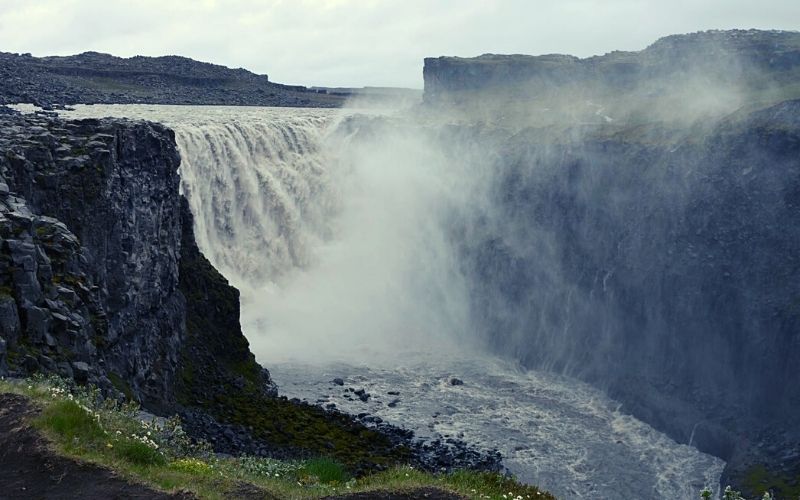
Dettifoss
Rjukandi Waterfall
Submitted by Džangir from Dr Jam Travels
Iceland is a land of great natural wonders. With an abundance of water, it has over 10.000 waterfalls, big and small. Among those worth mentioning is the Rjúkandi waterfall (Rjúkandifoss). At 139 meters high, it is one of the highest waterfalls in northern Iceland.
The waterfall is located in Austurland (eastern Iceland) in the Jökuldalur valley. It is easily accessible and is one of the few waterfalls in this area that is right next to Ring Road. The closest town is Egilsstaðir in the Fljótsdalshérað municipality which is about 50 kilometers away and reachable in a bit more than half an hour.
There is a gravel car park and a rest area where you can sit on benches and enjoy a nice view of the waterfall. You can climb to the top of the waterfall by following the 800 meter long trail that can be climbed in 15 minutes and with modest effort. There you can sign in to the visitor logbook.
The best time to visit this place would be from May until September.
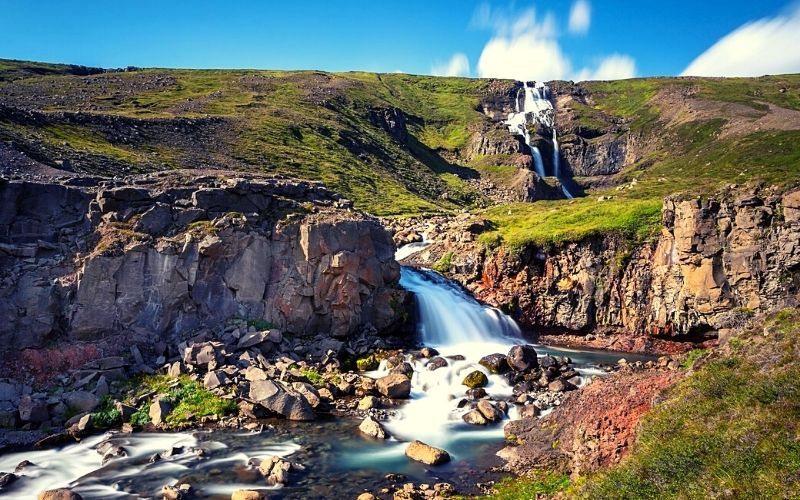
Rjukandi waterfall
Bonus Waterfall
These are some of the most beautiful and the most famous waterfalls, but as mentioned, there are over 10,000 waterfalls in Iceland. Keep your eyes peeled as you are driving along or hiking because you are bound to spot some smaller and less visited ones.
We stayed in a beautifully converted former farm building with its own waterfall in the grounds! The accomodation is called The Garage and is located about a 10 minute drive from Skogafoss in one direction and 10 minutes from Seljalandsfoss in the other direction. Check out our 6 day Iceland itinerary for more information on where we went and where we stayed.
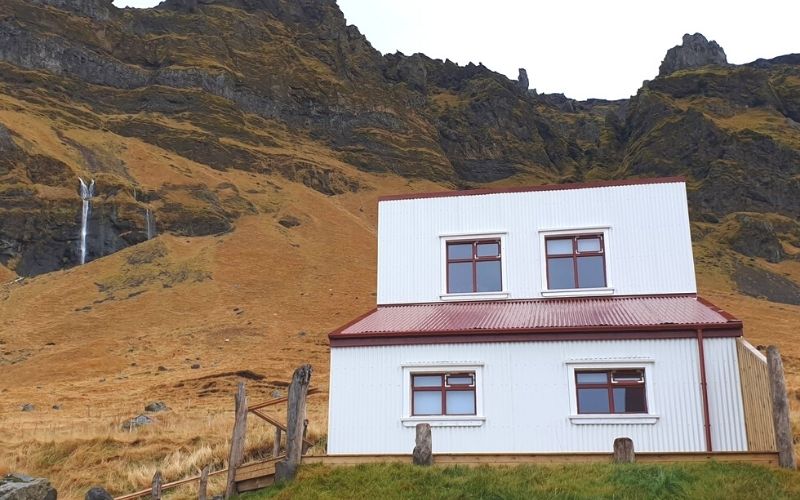
The Garage near Skogafoss and Seljalandsfoss
Iceland waterfalls map
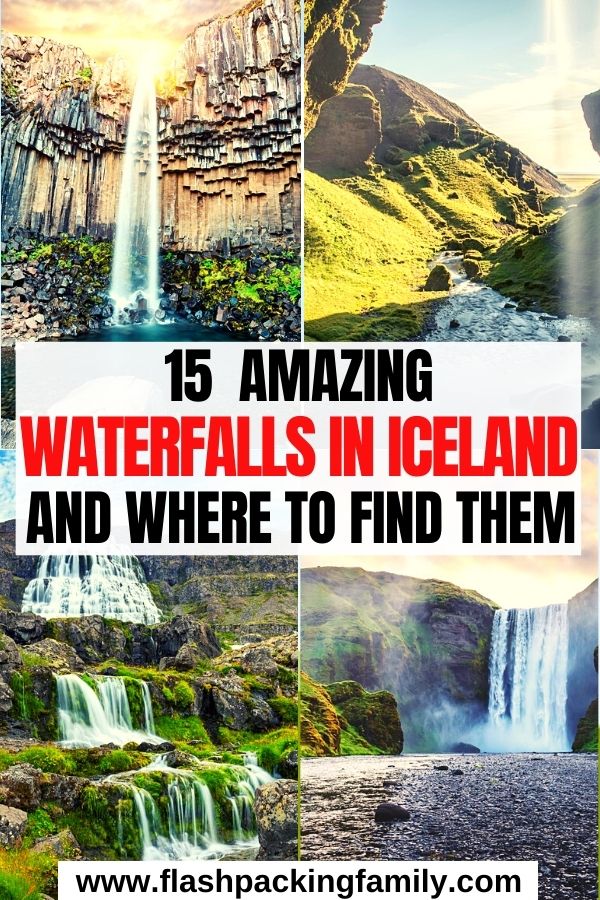
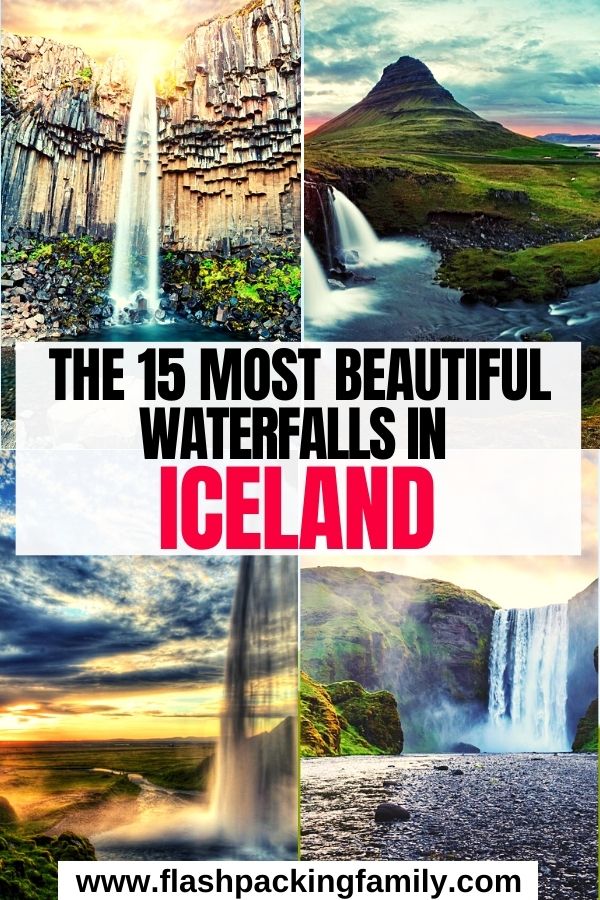



Leave a Reply
Want to join the discussion?Feel free to contribute!